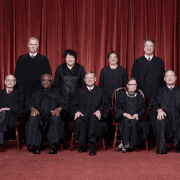How to Bring My Fiancé(e) to the U.S — A Comprehensive Couple’s Guide to U.S Immigration
Are you planning to permanently live together with your foreign fiancé(e) is the United States? Well, congratulations! But, before your spouse is allowed to enter the USA, you’ll need to help him or her to secure a K-1 visa.
Navigating through this bureaucratic process, however, is undeniably a daunting task, as it involves a lot of steps with plenty of paperwork to demonstrate whether your application is “bona fideâ€. If you want to increase your chances of winning approval for a K-1 visa, it’s recommended to work with a reputable and trusted Immigration law firm.
In this our couple’s guide to U.S immigration, we’ve simplified the process by covering every facet in a step-by-step manner. There’s everything you need to know to secure permanent resident status and citizenship for your fiancé(e).
What is K-1 Visa?
Also known as a fiancée visa, a K-1 visa is basically a temporary visa, which is issued by the U.S Department of State (DOS) consular officer to the fiancé(e) of a U.S citizen for one reason — getting married within 90 days of admission to the U.S This K-1 nonimmigrant visa is not issued to a fiancé(e) of a U.S Green Card holder. There’s the CR1 visa option, though. However, it takes time to process, typically two years or longer.
To qualify for a K-1 visa, you as the petitioner (U.S citizen) must convince the U.S Citizenship and Immigration Services (USCIS) agents of your intentions to establish a life together with your spouse. An application perceived as a strategy to obtain an immigration benefit will surely not win approval.
Without further ado, here are the steps you’ll need to follow to bring your fiancée to the U.S:
Step One: Assembling documents to demonstrate your application is “bona fideâ€
• Schedule for an in-person meeting with your spouse
Before you start the K-1 visa application process, you should be able to prove that both of you have actually met in person outside the U.S at least within the last 2 years.
This rule does not only apply to couples who met over the internet and fell in love with each without making contact, but also those who have been apart for the last 2 years. And as part of the documentation, you can provide photos, hotel receipts, airline receipts, etc.
There’s an exception to this requirement if you can prove that traveling to meet your fiancé (e) oversees will simply lead to extreme hardship to you. Or, the in-person meeting will be a violation of certain strict well-known customs or religious traditions of your spouse.
• Confirm you are both legally allowed to marry
Once you have met the in-person meeting requirement, you’ll need to have documents that prove both of you are free to get married in the U.S. If you have been in any previous marriages, a divorce decree, annulment, or death certificate can serve as a proof.
If your spouse already has kids, they may be allowed to come to the U.S only if they are under 21 and unmarried. Also, of course, if they want to come. And if that’s the case, their names should be included in the K-1 visa. But, kids will need a K-2 nonimmigrant visa in order to qualify for admission.
While your fiancé(e) and the kids may be eligible, you should be informed that the kids are not allowed to travel to the U.S before your spouse. Make sure the children travel with your spouse or they can follow to join at a later date. If they will travel later, then it should be within the validity of their K-2 visas.
• Meet the visa income requirement
As a petitioner, you need to meet a certain minimum income requirement, depending on the state you live in and the number of aliens you are planning on sponsoring. This is a requirement by the government to reduce the likelihood that your fiancé(e) will become a ward of the state. You are required to sign an affidavit pledging your support to your fiancée, and then promise that for at least 10 years you won’t apply for public aid in order to help him or her.
Step two: Filing a K-1 visa petition
The paperwork process to bring your fiancée in the United States starts with filing a K-1 visa petition. But first, it’s imperative that you familiarize yourself with all the branches involved in the immigration process. There’s the USCIS, the U.S Department of State (DOS), and the Customs and Border Protection.
There are different stages involved, and their nature typically includes thoroughly verifying background and security checks on a couple. Fingerprints, biographic, or biometric data may be required to obtain the criminal history or any other information deemed necessary for visa approval.
When applying for a fiancé(e) visa, your Form 1-129F should be submitted to the USCIS center that serves the area where you live. Your form may be declined if filed at the U.S Consulate, Embassy, or USCIS office abroad.
Here is what you’ll need to do when filing for 1-129F:
• Download the petition from the USCIS website: Be sure to carefully go through the form instructions before you start filling it out. If anything is not clear or have any questions, don’t hesitate to consult with an immigration attorney.
• Submit the necessary list of documents to support your petition: In addition to the documents we discussed in step one above; you’ll need to provide documentary proof of your U.S citizenship. Your copies of U.S. passport or U.S. birth certificate are sufficient. Another important piece of documents are the passport-style color photographs for both you and your fiancée. However, these photos must have been taken within the 30 days before filing the petition.
Keep in mind USCIS agents may require that some documents be submitted in their original copies, especially original signed forms or letters. But don’t send originals if you are not requested to, otherwise, you risk losing your important documents.
• Confirm the filing fee: When you’ve completed your petition, you should ensure that your check or money order is the exact amount of the required fee.
• Mail your documents: Assemble all the documents and be sure to double check before submitting. When satisfied, you can mail your package to USCIS.
After a petition is submitted, USCIS may mail you a notice acknowledging receipt or requesting additional evidence and information to supplement your petition.
If the documents are convincing enough to establish eligibility, the agents will approve your application. If unfortunately, your form is rejected, then you’ll receive a notification with the reasons for rejection
An approved Form 1-129F will be forwarded to the DOS National Visa Center (NVC), which is responsible for transferring the file to the U.S Embassy or Consulate in your foreign-born fiancée place of residence. You, the U.S citizen, will also receive a case number from NVC.
Step three: Applying for a visa
As soon as you receive a mail from NVC upon approval, you should inform your fiancé(e) to proceed with the K-1 nonimmigrant visa application process and follow the additional instructions such as completing the online application and sending additional required documents. You’ll also be notified of the exact date when your fiancé(e) will be required for the visa interview.
During the scheduled interview with a DOS consular officer, your spouse overseas applying for K-1 visa will need to present the following forms and documents:
• A valid travel passport: The passport to the United States must be valid for not less than 6 months beyond the anticipated period your spouse will stay in the U.S.
• Death, divorce, or birth certificates: Include copies of the U.S citizen petitioner as well as the fiancé(e).
• Medical examinations: The medical examinations are mandatory, regardless of age. Such tests are performed only by panel physician authorized by the U.S Embassy or Consulate.
• Proof of relationship: Although you had provided this in the first step of the K-1 visa application, your fiancée will also need to do the same to prove that your relationship is indeed genuine.
• Police reports or certificates: The certificates needed must be from your fiancée’s country of residence. Police reports or certificate from the other countries where she has lived for at least 6 months can also count. This requirement is also applicable to children at least 16 years old.
• A duly completed Form DS-160: The under 21 children of a K-1 visa applicant may be eligible to apply for K-2 visas. Both your fiancée and the kids will be required to complete Form DS-160. What they’ll need to present during the interview is a printed DS-160 confirmation page.
• Proof of financial support: Evidence to prove that your spouse will be able to support herself/himself and not become a public charge in the U.S.
It is important to note that these are not all the requirements. The consular officer may require additional information and evidence to make a decision whether your spouse and children qualify for the K-1 and K-2 visa.
Step four: Lawful entry into the U.S (Inspection at a Port of Entry)
While a valid visa issued by DOS consular officer will enable your fiancée to travel to the US port of entry, it’s not a guarantee that they’ll be permitted to enter into the U.S. Your spouse will be required to comply with the U.S Customs and Border Protection rules and regulations.
When he or she arrives at the port of entry, they should provide the documents as asked by the CBP officers. The nature of the process typically involves presenting a traveling passport with visa. If your fiancé(e) has a sealed packet containing documents, the officers have a right to check it and make the ultimate decision.
To avoid surprises at a port of entry, it’s generally recommended for all travelers planning to enter the U.S to visit the official CBP website under travel to check out the key information in regards to admission and entry requirements.
Step five: Getting Married
After your spouse is admitted to the US, you’ll have a 90 day period to plan and fully legalize your relationship by getting married. It’s best to make this happen as soon as possible because the marriage certificate you receive will be required when applying for a Green Card. Unfortunately, though, this specific period cannot be extended for any reason.
If by the end of this period you have not yet been married, then the temporary K-1 and K-2 visa will automatically expire. This could mean your foreign spouse together with the kids will need to depart from the United States. Failure to do this will be treated as a violation of immigration law, which could affect future eligibility.
Step six: Adjusting of Status (AOS)
With a marriage visa, your spouse is considered eligible to apply for a Green Card. They’ll need to file Form 1-485, Application to Register Permanent Residence or Adjust Status.
The children admitted as K-2 immigrants can also apply for a Green Card. Although, they are required to remain unmarried, otherwise, they’ll lose their eligibility.
After filling the application, your wife or husband should check their email regularly. It is because USCIS may mail them a request for additional information or an appointment notification requiring a couple to attend an interview. The interviews will not take much of your time, as they last for about 30 – 45 minutes.
USCIS usually schedules for interviews during the adjustment of status, because they want to fully confirm the documents and information that a couple had submitted on the application.
Interviews also provide the officers in charge of the application an opportunity to see whether circumstances have changed, rendering you ineligible for an adjustment of status.
While each case is different, the AOS process may take 6-8 months. And if at the time of approval the length of your marriage is less than 2 years, your spouse will receive a Green Card with a conditional permanent resident status for 2 years which must be renewed in 90-day window prior to 2 year anniversary of green card issuance. In all cases, notifications of these immigration benefits are made in writing.
To secure permanent resident status as a conditional resident, your spouse must file Form 1-751 within the last 90 days before their Green Card becomes invalid.
If you have been married to your spouse over 2 years at the time of green card issuance, your spouse will obtain a 10-year unconditional green card.
There you have it! Contact us today or please call us with any fiancee visa questions at (866)691-9894.












